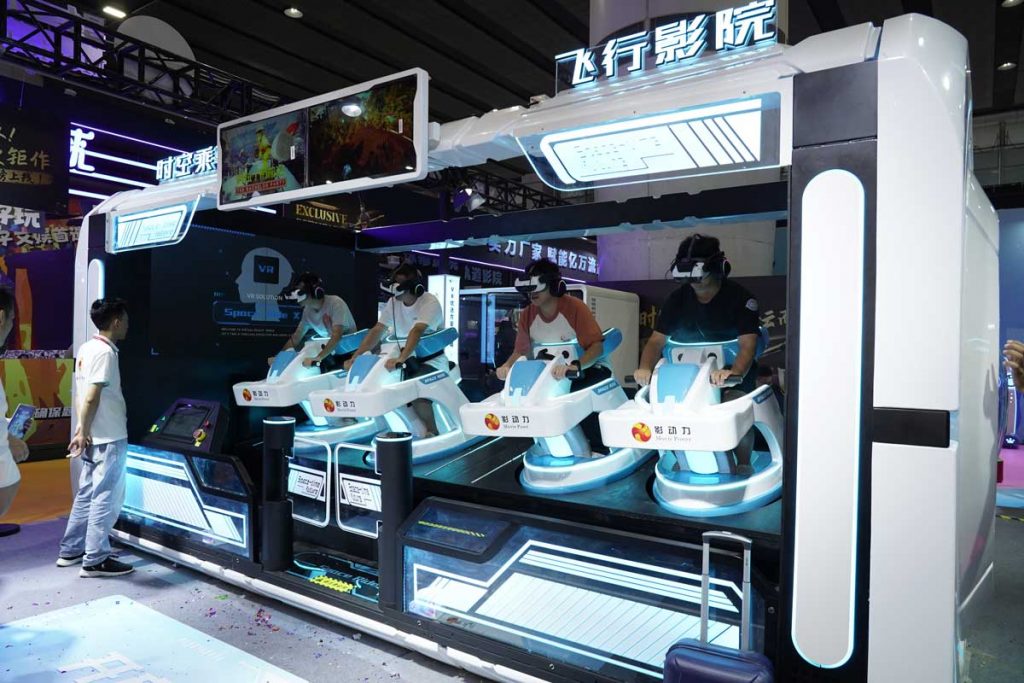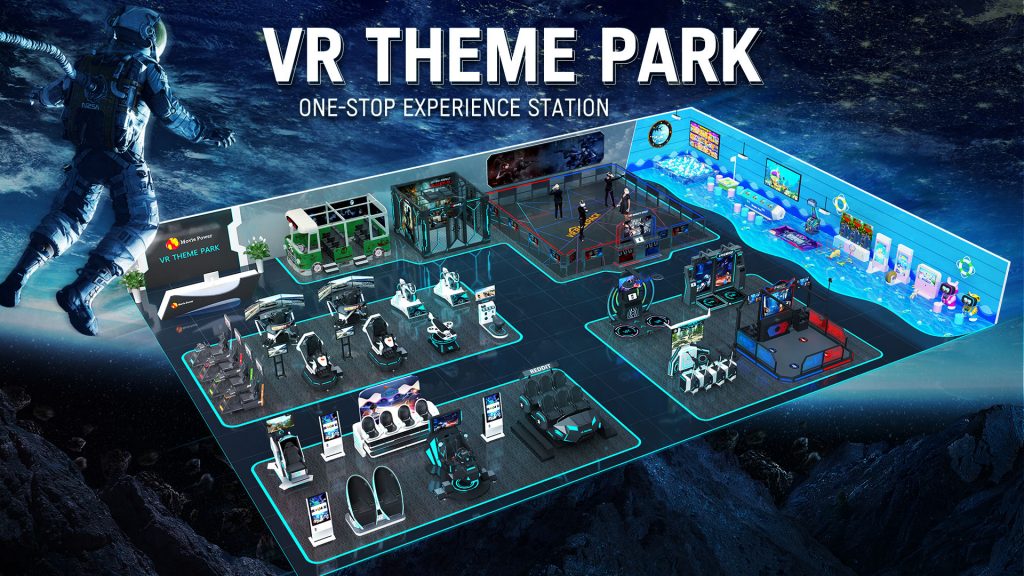广州趣空间科技有限公司, 有限公司.
FunSpace是专注于自主研发的街机供应商和制造商, 开发生产,投币街机游戏机的销售和服务.
联系我们
电话: 0086 18011735497
电子邮件: [email protected]
地址: 不. 42 始新路, 东环街, 番禺区 , 广州, 中国.
菜单
与虚拟现实 (虚拟现实) 成为一个快速发展的行业, 开设VR街机业务带来了令人兴奋且可能有利可图的机会. 本指南将为您提供打开自己的VR街机的分步方法, 涵盖从市场研究和成本到营销策略和盈利能力的一切. 如果您准备将对VR的热情转变为业务, 本指南是给你的!
VR街机是一个物理位置,客户可以使用VR耳机和专业设备体验虚拟现实游戏或娱乐. 这些街机使用户可以沉浸在数字世界中, 提供从高辛烷值动作游戏到宁静模拟的所有内容.

VR行业正在迅速发展. 曾经被认为是利基技术, VR已成为主流娱乐媒体. 随着VR硬件变得更加实惠,内容变得更加多样化, VR Arcades在世界各地的城市中弹出. 这使其成为开展VR街机业务的理想时机, 随着对沉浸式娱乐体验的需求正在增加.
本文将为开展VR街机业务提供综合指南. 我们会穿过每个阶段, 从了解市场趋势到制定业务计划, 管理成本, 并评估盈利能力.
全球VR行业正在蓬勃发展. 经过 2026, 据估计,市场规模超过了 $50 十亿. VR在许多领域都有应用, from gaming to education and healthcare, but entertainment and gaming remain dominant. As more consumers seek out immersive entertainment experiences, VR arcades are well-positioned to capitalize on this trend.
VR appeals to a wide range of audiences, from hardcore gamers to families and corporate groups. Understanding your target market is key:
Before starting a VR business, you need to assess the demand in your local area. 附近是否还有其他VR街机或类似的娱乐场所? 他们提供什么经验? 确定市场上的差距将帮助您定义利基市场并吸引客户.
如果您所在地区还有其他VR街机, 您需要区分业务. 也许您可以提供独特的游戏, 更好的客户服务, 或其他便利设施,例如小吃店或聚会主持人. 了解您的竞争将有效地定位VR街机.
选择合适的业务模型至关重要. 考虑以下选项:
您的业务计划应包括详细的财务预测. 估算您的启动成本, 运营费用, 和潜在的收入. 例如, 计算租用空间的成本, 购买VR设备, 人员配备, 营销, 和保险. 然后, 根据您的定价模型计划您的预期流量和收入.
位置是成功的VR街机的关键. 购物中心等高流量地区, 娱乐区, 或在电影院附近可以帮助您吸引客户. 考虑可访问性, 停車處, 以及为您的VR街机业务选择网站时的整体环境.
开始VR街机业务需要大量资本, 特别是用于设备和租赁. 考虑资金选项,例如:
考虑初始设置和持续的运营成本, 开展VR街机业务的总成本范围从 $120,000 到 $330,000 或更多. 这是一个粗略的崩溃:
启动VR街机的成本可能会取决于几个因素, 例如街机的大小, 地点, 设备类型, 以及您计划提供的服务. 以下是开始VR街机业务时需要考虑的关键支出的细分:
这些是设置VR街机的一次性费用:
VR设备: 购买设备是开展VR街机业务的最重要一步, 这也是最昂贵的步骤. 市场上的VR设备便宜且昂贵, 主要基于机器中使用的技术及其带给客户的体验. 价格估计为$ 7,000〜 $ 50,000. 成本估算: $50,000-$70,000 每个站.
翻新和室内设计: 设置街机将需要为每个VR站创建摊位或播放空间, 安装安全措施等安全措施, 并设计空间以提供舒适的, 沉浸式经验. 成本估算: $5,000 - $ 30,000, 取决于大小和设计复杂性.
其他设备: 额外费用将包括家具 (椅子, 等待区), 装饰, 灯光, 以及其他改善客户体验的便利设施. 成本估算: $2,000 - 10,000美元, 取决于设置.
一旦您的VR街机业务开始并运行, 您将面临定期每月费用, 包括:
租: 您的租赁费用可能是最大的持续费用之一. 这会因位置和空间的大小而异. 成本估算: $2,000 - 每月10,000美元.
薪水: 您需要员工来管理街机, 包括客户服务代表, VR技术人员, 和经理. 取决于街机的大小, 您可能需要 3 到 10 雇员. 成本估算: $20,000 - 每年50,000美元, 取决于员工和当地工资的数量.
公用事业: 电, 互联网, 其他公用事业对于运行街机是必需的. 高性能游戏PC和VR设备消耗了重要的功率. 成本估算: $500 - 每月$ 1,500.
设备维护及升级: VR硬件可能会定期使用, 因此,您需要考虑维修和更换成本. 您可能还想升级硬件,因为新系统可用. 成本估算: $1,000 - 5,000美元 每年.
营销和广告: 吸引和留住客户, 您需要投资于营销策略, 包括在线广告, 社交媒体运动, 本地促销, 和合作伙伴关系. 成本估算: $500 - 每月2,000美元.
保险: 商业保险是防止责任的必不可少的, 设备损坏, 和潜在的事故. 您还需要考虑健康和安全合规保险. 成本估算: $1,000–$3,000 每年.
Choosing the right VR arcade machine is one of the key factors for the success of opening a VR arcade business. VR arcade machines usually refer to all-in-one machines that integrate virtual reality equipment, 软件, games and management systems, and are specially designed for commercial entertainment environments. These machines usually come with a range of pre-installed VR games and experiences, and are easy to operate and maintain.
Here are a few key aspects to consider when choosing a VR arcade machine:
VR arcade machines can be divided into several types, each with different characteristics and application scenarios:
The types of games and experiences provided by the VR arcade machine are the core of determining customer satisfaction and attraction. When choosing a machine, make sure it supports diverse content:
Commercial VR arcade machines should be easy to operate and maintain. The following points are worth noting:
The hardware performance of the VR arcade machine directly affects the smoothness and immersion of the experience. The following are key hardware parameters:
As commercial equipment, VR arcade machines need to have high durability to withstand frequent use. Here are a few points to pay attention to:
Choosing the right VR arcade machine is the basis for successfully opening a VR arcade business. You need to make decisions based on the target market, content needs, ease of operation, hardware performance, and budget. A high-performance, content-rich, easy-to-operate and maintain VR arcade machine can not only provide customers with a high-quality immersive experience, but also bring you efficient operations and profitability.
When designing your VR arcade, consider customer comfort and flow. Ensure there’s ample space for each VR station to avoid collisions and provide privacy. A well-organized layout also allows you to manage more customers during peak times.
Safety is a top priority. Install padded flooring, clearly mark boundaries, and ensure customers are briefed on how to safely use the equipment. Make sure your VR arcade is accessible to everyone, including people with disabilities.
The atmosphere of your VR arcade should reflect the immersive nature of VR. Consider using futuristic lighting, 音效, and thematic decor to enhance the experience. Comfortable waiting areas and refreshments can also boost customer satisfaction.
广州趣空间科技有限公司, 有限公司. is a leading one-stop solution provider for game consoles and vending machines in China. 成立于 2008, 公司已与 3,000 合作伙伴包括游乐园, 购物中心, 家庭娱乐中心, rental companies, ETC。, providing professional design, 规划, production and 24-hour after-sales service.
We provide professional VR theme parks one-stop solutions, from product selection to site design to final product installation and testing, we can help you solve it in one step!

You’ll need to officially register your business as a legal entity. Choose between a sole proprietorship, LLC, 或公司, depending on your needs.
Ensure you obtain all necessary business licenses and permits. 取决于您所在的位置, this may include entertainment venue licenses, zoning permits, and health and safety compliance.
Business insurance is a must. Get coverage for liability, 设备损坏, and business interruption to protect against unexpected events.
Since VR can sometimes cause motion sickness or disorientation, have customers sign liability waivers before participating. This protects you legally if any accidents or injuries occur.
A successful VR arcade relies on knowledgeable and friendly staff. Key roles include:
Proper training is essential. Ensure your staff understands how to operate and maintain the equipment and can provide excellent customer service.
Your staff will be dealing with many first-time VR users, so patience and clear communication are important. Making the experience easy and enjoyable for newcomers will encourage repeat visits.
Create a memorable brand that resonates with your target audience. A catchy name, 标识, and theme will help differentiate your VR arcade business from the competition.
A strong online presence is essential for attracting customers. Build a professional website where users can book sessions, view games, and learn about your VR arcade. Social media platforms like Instagram, Facebook, and TikTok can help showcase gameplay and customer experiences.
Optimize your website for local search results. Register your business on Google My Business and Yelp to increase your visibility. Encourage customers to leave reviews, which will boost your reputation.
Run promotions to attract new customers. Offer discounts for first-time visitors, group rates, or bundle deals. Loyalty programs can help incentivize repeat business.
Partner with nearby businesses, such as restaurants, 电影院, or event spaces, to create cross-promotions. 例如, offer a discount for customers who show a receipt from a local restaurant.
Consider a soft launch to test your operations and work out any kinks before your official grand opening. A soft launch allows you to gather feedback from a smaller group of customers. 然后, host a grand opening event to attract more attention, complete with promotions, giveaways, and media coverage.
During your grand opening, offer discounts, run contests, or partner with local influencers to generate buzz. Make sure to announce the event on social media and through local media outlets.
Encourage your first customers to leave feedback and reviews. This will not only help you improve but also build social proof for potential customers.
The profitability of your VR arcade business depends on a variety of revenue streams:
Keep customers coming back by regularly updating your game library, offering loyalty programs, and organizing special events. The more fresh and exciting your offerings, the more likely customers are to return.
VR arcades typically have a high initial investment, but once operational, they can generate healthy profit margins. The break-even point varies depending on location, 成本, and pricing, but many successful VR businesses can break even within 12-24 几个月.
Look to existing VR arcades that have scaled successfully by expanding into new locations or franchising their model. These businesses demonstrate that profitability is achievable with the right strategy.
Implement an efficient booking system to manage reservations and reduce wait times. Ensure your staff is well-trained to handle customer service, troubleshoot equipment issues, and manage busy periods.
随着您的业务增长, consider introducing new games or offering niche VR experiences like educational programs or fitness activities. Adding food and beverages or merchandise sales can enhance customer experience and boost revenue.
If your VR arcade is successful, you might consider expanding to additional locations or franchising your business model. This allows you to tap into larger markets and grow your brand regionally or nationally.
Starting a VR arcade business is an exciting venture with significant potential. From conducting market research and developing a business plan to setting up your arcade and attracting customers, there’s a lot to consider. 然而, 精心策划, a focus on customer experience, and a solid marketing strategy, you can create a profitable and sustainable virtual reality gaming business.
Take the next step today—immerse yourself in the world of VR, and bring that immersive experience to your customers!
给我们发信息
广州趣空间科技有限公司, 有限公司.
FunSpace是专注于自主研发的街机供应商和制造商, 开发生产,投币街机游戏机的销售和服务.
联系我们
电话: 0086 18011735497
电子邮件: [email protected]
地址: 不. 42 始新路, 东环街, 番禺区 , 广州, 中国.
广州趣空间科技有限公司, 有限公司.
FunSpace是专注于自主研发的游戏机供应商和制造商, 开发生产,投币街机游戏机的销售和服务.
联系我们
电话: 0086 18011735497
电子邮件: [email protected]
地址: 不. 42 始新路, 东环街, 番禺区 , 广州, 中国.
WhatsApp我们
